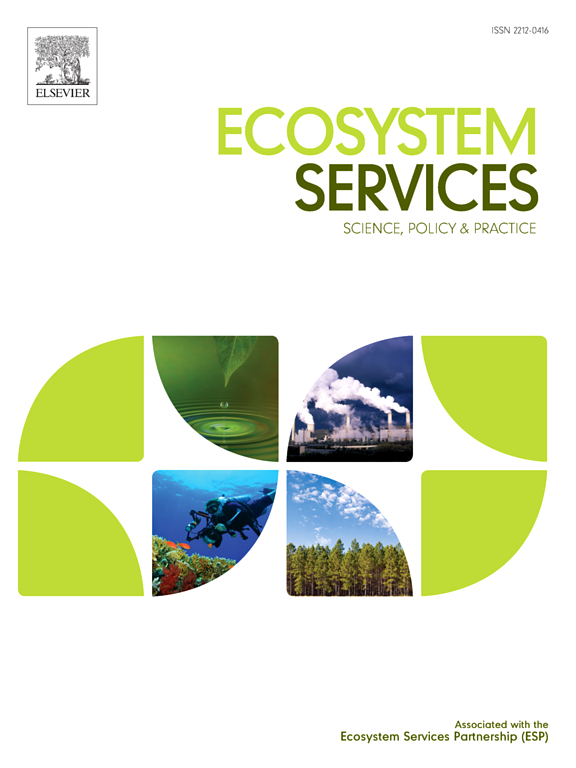Disentangling cultural ecosystem services co-production in urban green spaces through social media reviews
IF 6.6
2区 环境科学与生态学
Q1 ECOLOGY
引用次数: 0
Abstract
Urban green spaces (UGS) are vital for providing cultural ecosystem services (CES) that enhance well-being in cities. CES are co-produced through human interactions with the environment and involve natural, built, human, and social capital. Assessing CES through textual social media reviews on platforms such as Google Maps, offers insights into the intricate relationships between UGS characteristics, human activities, and well-being. However, research gaps regarding the role of co-production factors in the final delivery of CES persist, necessitating an improved conceptualization of CES co-production. This study provides a comprehensive exploration of the co-production of CES in UGS by analyzing 15,450 Google Maps reviews in the German cities of Bochum and Gelsenkirchen. The research assesses both the “use clause” and “ecological clause” of CES, offering a nuanced understanding of user perceptions and the contributions of UGS characteristics. Key findings highlight the entangled significance of CES categories, such as “aesthetic experiences,” “active or immersive interactions,” and “passive or observational interactions,” revealing that aesthetic value acts as a catalyst for both active and passive interactions within UGS. The study also demonstrates the intricate relationship between CES and the (perceived) biophysical environment, suggesting tangible and material connections to the natural and built environment, contrary to existing intangibility claims. The analysis of low-intensity and experience-oriented recreational activities highlights the reliance on specific UGS characteristics. The study concludes by acknowledging the strengths of utilizing textual social media reviews for CES assessment, particularly in their ability to cover a broad range of UGS classes in urban contexts. Our research enhances understanding of CES co-production in UGS, emphasizing the interplay between UGS characteristics, user experiences, and CES co-production. This provides insights for UGS planning and guides research on material aspects of CES co-production and capital interactions.
通过社交媒体评论解构城市绿地中的文化生态系统服务共同生产
城市绿地(UGS)对于提供文化生态系统服务(CES),提高城市的幸福感至关重要。文化生态系统服务是通过人类与环境的互动共同产生的,涉及自然资本、建筑资本、人力资本和社会资本。通过谷歌地图等平台上的文本社交媒体评论来评估 CES,可以深入了解城市综合体特征、人类活动和幸福感之间错综复杂的关系。然而,关于共同生产因素在 CES 最终交付中的作用的研究仍然存在差距,因此有必要改进 CES 共同生产的概念。本研究通过分析德国波鸿市和盖尔森基兴市的 15450 条谷歌地图评论,全面探讨了用户体验服务在用户体验服务中的共同生产。研究同时评估了 CES 的 "使用条款 "和 "生态条款",为用户感知和 UGS 特性的贡献提供了细致入微的理解。研究的主要发现强调了 "美学体验"、"主动或沉浸式互动 "和 "被动或观察式互动 "等 CES 类别之间相互纠缠的意义,揭示了美学价值对 UGS 内主动和被动互动的催化作用。这项研究还证明了 CES 与(感知到的)生物物理环境之间错综复杂的关系,表明了与自然环境和建筑环境之间有形的物质联系,这与现有的无形性说法恰恰相反。对低强度和以体验为导向的娱乐活动的分析强调了对特定城市和地方政府特征的依赖。研究最后肯定了利用文本社交媒体评论进行 CES 评估的优势,特别是其涵盖城市环境中广泛的 UGS 类别的能力。我们的研究加深了人们对用户体验共同生产的理解,强调了用户体验共同生产的特点、用户体验和用户体验共同生产之间的相互作用。这为城市综合服务系统的规划提供了启示,并指导了对消费电子产品共同生产和资本互动的物质方面的研究。
本文章由计算机程序翻译,如有差异,请以英文原文为准。
求助全文
约1分钟内获得全文
求助全文
来源期刊

Ecosystem Services
ECOLOGYENVIRONMENTAL SCIENCES&-ENVIRONMENTAL SCIENCES
CiteScore
14.90
自引率
7.90%
发文量
109
期刊介绍:
Ecosystem Services is an international, interdisciplinary journal that is associated with the Ecosystem Services Partnership (ESP). The journal is dedicated to exploring the science, policy, and practice related to ecosystem services, which are the various ways in which ecosystems contribute to human well-being, both directly and indirectly.
Ecosystem Services contributes to the broader goal of ensuring that the benefits of ecosystems are recognized, valued, and sustainably managed for the well-being of current and future generations. The journal serves as a platform for scholars, practitioners, policymakers, and other stakeholders to share their findings and insights, fostering collaboration and innovation in the field of ecosystem services.
 求助内容:
求助内容: 应助结果提醒方式:
应助结果提醒方式:


